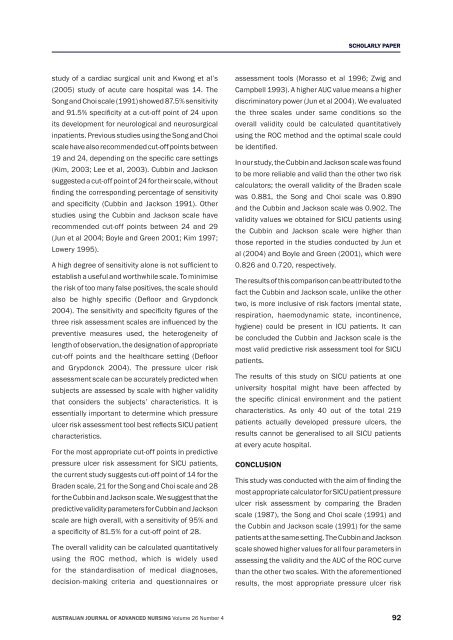australian journal of advanced nursing
australian journal of advanced nursing
australian journal of advanced nursing
You also want an ePaper? Increase the reach of your titles
YUMPU automatically turns print PDFs into web optimized ePapers that Google loves.
study <strong>of</strong> a cardiac surgical unit and Kwong et al’s<br />
(2005) study <strong>of</strong> acute care hospital was 14. The<br />
Song and Choi scale (1991) showed 87.5% sensitivity<br />
and 91.5% specificity at a cut‑<strong>of</strong>f point <strong>of</strong> 24 upon<br />
its development for neurological and neurosurgical<br />
inpatients. Previous studies using the Song and Choi<br />
scale have also recommended cut‑<strong>of</strong>f points between<br />
19 and 24, depending on the specific care settings<br />
(Kim, 2003; Lee et al, 2003). Cubbin and Jackson<br />
suggested a cut‑<strong>of</strong>f point <strong>of</strong> 24 for their scale, without<br />
finding the corresponding percentage <strong>of</strong> sensitivity<br />
and specificity (Cubbin and Jackson 1991). Other<br />
studies using the Cubbin and Jackson scale have<br />
recommended cut‑<strong>of</strong>f points between 24 and 29<br />
(Jun et al 2004; Boyle and Green 2001; Kim 1997;<br />
Lowery 1995).<br />
A high degree <strong>of</strong> sensitivity alone is not sufficient to<br />
establish a useful and worthwhile scale. To minimise<br />
the risk <strong>of</strong> too many false positives, the scale should<br />
also be highly specific (Defloor and Grypdonck<br />
2004). The sensitivity and specificity figures <strong>of</strong> the<br />
three risk assessment scales are influenced by the<br />
preventive measures used, the heterogeneity <strong>of</strong><br />
length <strong>of</strong> observation, the designation <strong>of</strong> appropriate<br />
cut‑<strong>of</strong>f points and the healthcare setting (Defloor<br />
and Grypdonck 2004). The pressure ulcer risk<br />
assessment scale can be accurately predicted when<br />
subjects are assessed by scale with higher validity<br />
that considers the subjects’ characteristics. It is<br />
essentially important to determine which pressure<br />
ulcer risk assessment tool best reflects SICU patient<br />
characteristics.<br />
For the most appropriate cut‑<strong>of</strong>f points in predictive<br />
pressure ulcer risk assessment for SICU patients,<br />
the current study suggests cut‑<strong>of</strong>f point <strong>of</strong> 14 for the<br />
Braden scale, 21 for the Song and Choi scale and 28<br />
for the Cubbin and Jackson scale. We suggest that the<br />
predictive validity parameters for Cubbin and Jackson<br />
scale are high overall, with a sensitivity <strong>of</strong> 95% and<br />
a specificity <strong>of</strong> 81.5% for a cut‑<strong>of</strong>f point <strong>of</strong> 28.<br />
The overall validity can be calculated quantitatively<br />
using the ROC method, which is widely used<br />
for the standardisation <strong>of</strong> medical diagnoses,<br />
decision‑making criteria and questionnaires or<br />
SCHOLARLY PAPER<br />
assessment tools (Morasso et al 1996; Zwig and<br />
Campbell 1993). A higher AUC value means a higher<br />
discriminatory power (Jun et al 2004). We evaluated<br />
the three scales under same conditions so the<br />
overall validity could be calculated quantitatively<br />
using the ROC method and the optimal scale could<br />
be identified.<br />
In our study, the Cubbin and Jackson scale was found<br />
to be more reliable and valid than the other two risk<br />
calculators; the overall validity <strong>of</strong> the Braden scale<br />
was 0.881, the Song and Choi scale was 0.890<br />
and the Cubbin and Jackson scale was 0.902. The<br />
validity values we obtained for SICU patients using<br />
the Cubbin and Jackson scale were higher than<br />
those reported in the studies conducted by Jun et<br />
al (2004) and Boyle and Green (2001), which were<br />
0.826 and 0.720, respectively.<br />
The results <strong>of</strong> this comparison can be attributed to the<br />
fact the Cubbin and Jackson scale, unlike the other<br />
two, is more inclusive <strong>of</strong> risk factors (mental state,<br />
respiration, haemodynamic state, incontinence,<br />
hygiene) could be present in ICU patients. It can<br />
be concluded the Cubbin and Jackson scale is the<br />
most valid predictive risk assessment tool for SICU<br />
patients.<br />
The results <strong>of</strong> this study on SICU patients at one<br />
university hospital might have been affected by<br />
the specific clinical environment and the patient<br />
characteristics. As only 40 out <strong>of</strong> the total 219<br />
patients actually developed pressure ulcers, the<br />
results cannot be generalised to all SICU patients<br />
at every acute hospital.<br />
CONCLUSION<br />
This study was conducted with the aim <strong>of</strong> finding the<br />
most appropriate calculator for SICU patient pressure<br />
ulcer risk assessment by comparing the Braden<br />
scale (1987), the Song and Choi scale (1991) and<br />
the Cubbin and Jackson scale (1991) for the same<br />
patients at the same setting. The Cubbin and Jackson<br />
scale showed higher values for all four parameters in<br />
assessing the validity and the AUC <strong>of</strong> the ROC curve<br />
than the other two scales. With the aforementioned<br />
results, the most appropriate pressure ulcer risk<br />
AUSTRALIAN JOURNAL OF ADVANCED NURSING Volume 26 Number 4 92

















